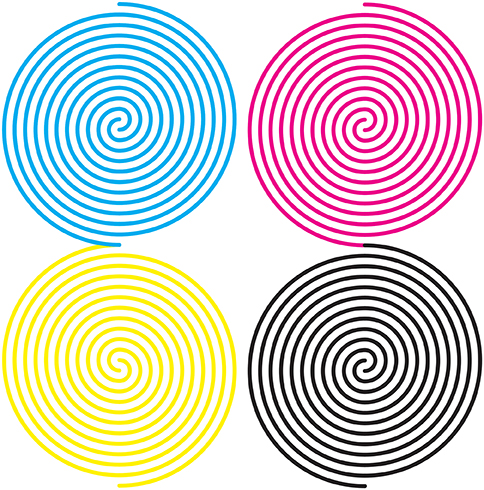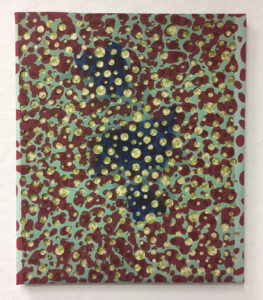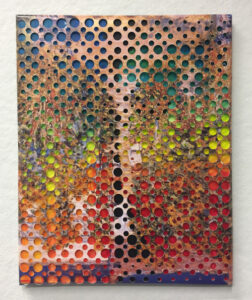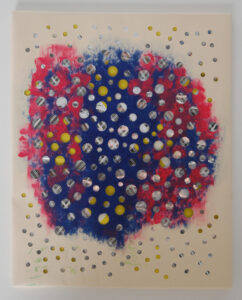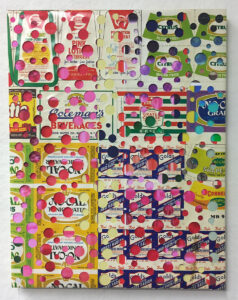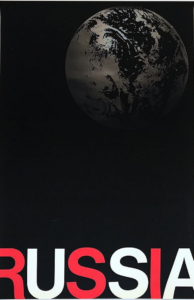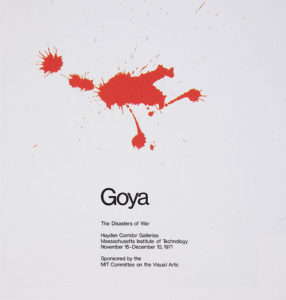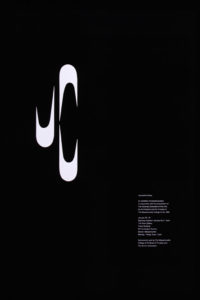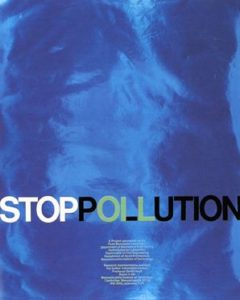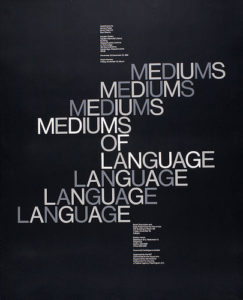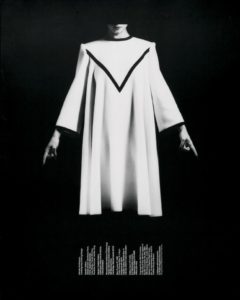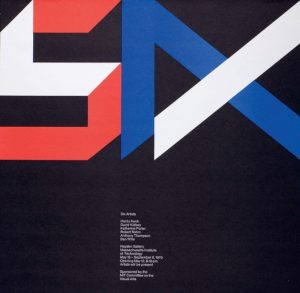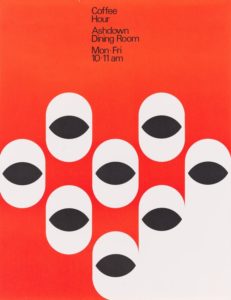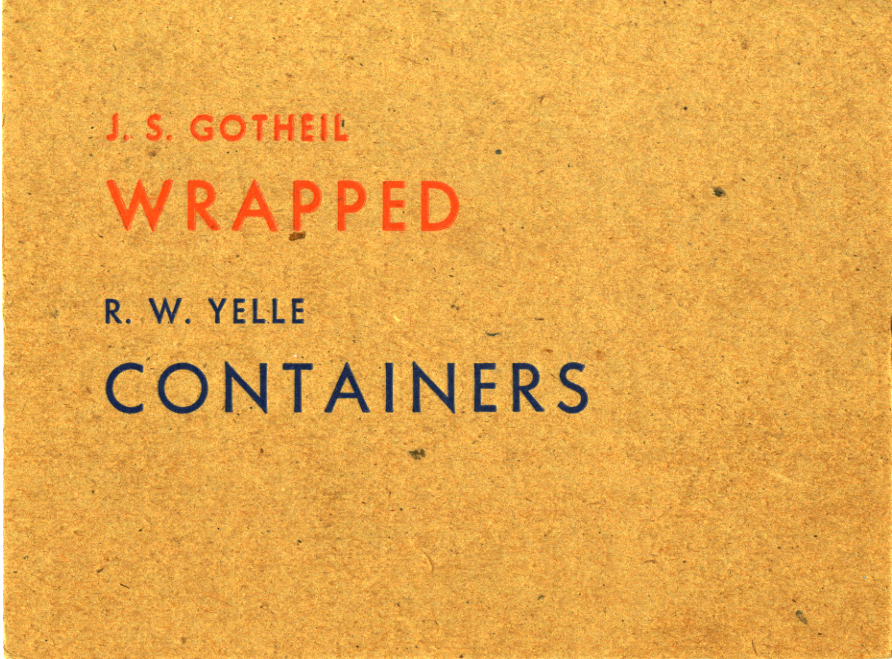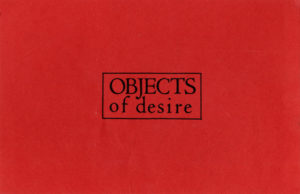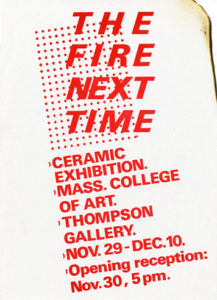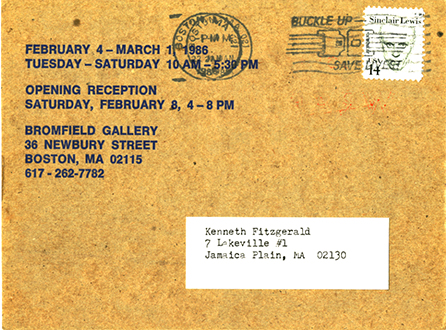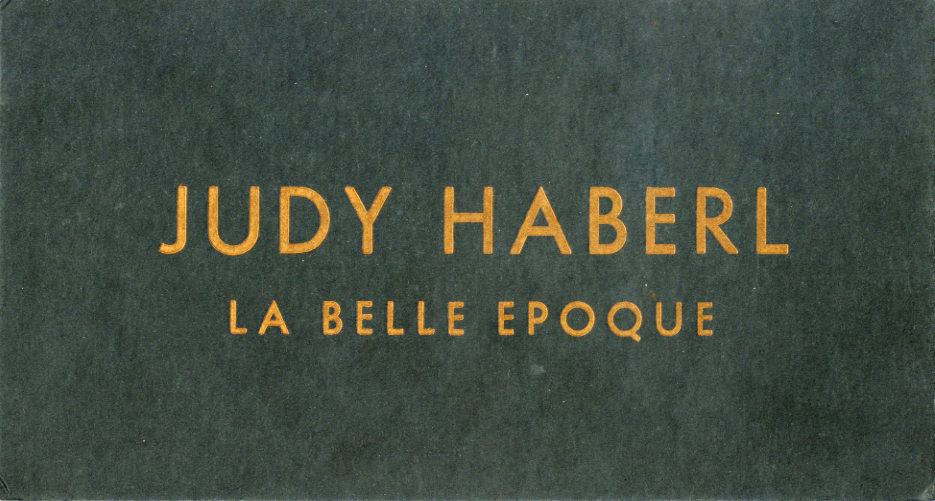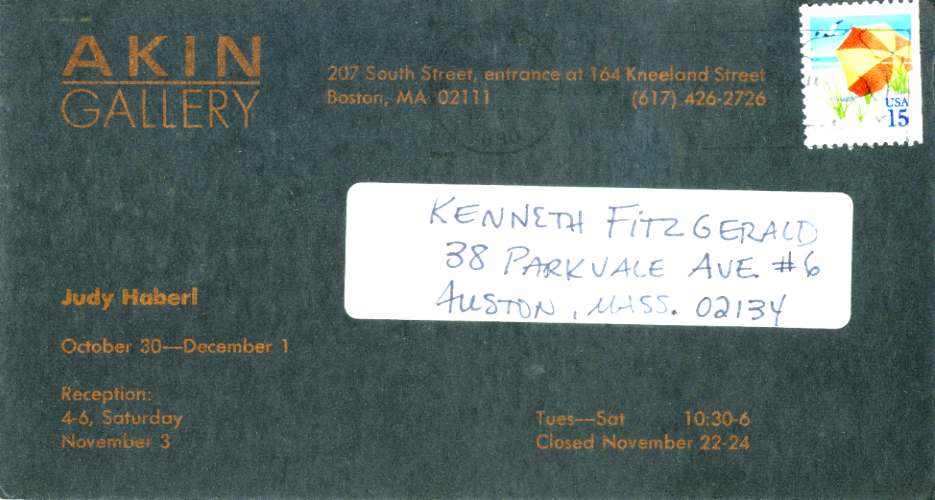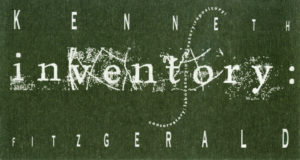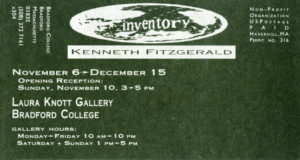My artwork Tape Z (top), sold in this year’s annual MassArt Art Auction, held in April. It was my third successive year of donations and sales, 30-year absence from the event when I wasn’t making art. My sales have raised over $1500 for student scholarship aid and academic program support at my twice-over alma mater. Works that have sold in previous years were Thrift Impression in 2022, and two works in 2021, Refractory and Liquid Color.
Tag: MassArt
The Graphic Designer and Her Presence
It’s Jacqueline Casey’s world, we’re just living in (a reflection of) it.
In the early 1990s, before ever envisioning a career in design, I spent months facing a framed copy of Jacqueline Casey’s 1985 poster Russia, USA Peace. It hung opposite my desk in the Massachusetts College of Art and Design Development office. Then I knew nothing about design’s history or Casey’s reputation. But the poster seemed to me ingenious and perfect—everything design was supposed to be.
The print came to the office via an exhibition of design alums I helped organize. At the opening reception, I chatted briefly with Jacqueline Casey. The show was my first exposure to her work and I expressed my appreciation to the frail, soft spoken woman. More than any other piece, or even her photo, when I look at Russia, USA Peace, I think of that short exchange of pleasantries. After all, she was in it, as was everyone on our planet.
The poster features a monochrome photo of Earth, shown in full in the upper right corner. Printed in a varnish, it floats in a black void that fills the poster’s frame. At the base of the poster runs the letters RUSSIA, the R and concluding A extending off the trim edges. The characters alternate in a solid, vivid red and reversed out white, which form USA.
Casey created the work for the exhibition Images for Survival organized by the Japanese Shoshin Society. The collection marked the 40th anniversary of the atom bombing of Hiroshima. At the time, a nuclear conflict between the two superpowers was the direst threat to humanity. Russia was then, technically, the USSR. Now, the poster seems prescient and timeless—both in appearance and message.
In all of Casey’s oeuvre, this work may be most emblematic of her method. She was the foremost U.S. practitioner of the International Style and deserves inclusion among its exemplars anywhere. While Müller-Brockmann is the style’s most renowned and doctrinaire practitioner, it was Casey that fully demonstrated its potential as an accessible design methodology. Müller-Brockmann may have generated the most music posters in the manner but it took Casey to make that style sing.
Casey represented an advance for the International Style separate from the “New Wave” represented by Wolfgang Weingart. (And it took another supremely talented American woman designer—April Greiman—to make that approach resound.) New Wave sought to bring down to Earth an airless typography (“do we live on the Moon?”). It didn’t make it breathe so much as make it hyperventilate.
In her process and product, Casey bridged the Swiss and American Modern strains: a fusion of the best Müller-Brockmann (discipline and structure) and Paul Rand (personability and formal imagination) could offer. She was the fulfillment of Modern intent, methodical and human.
High Modernist design overall developed from a celebration of mechanization and systemization. Its foremost performers operated sleek, clock-work devices of representation. Casey became the ghost in that machine.
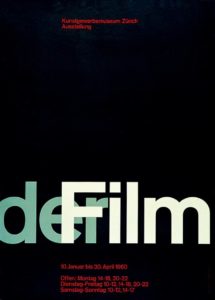 A comparison of Der Film and Russia, USA Peace is instructive. Both are signature works of the respective designers. The core aspect of each is a depiction of an effect of light: Casey using varnish, Müller-Brockmann an overlap that implies light projected through a transparency.
A comparison of Der Film and Russia, USA Peace is instructive. Both are signature works of the respective designers. The core aspect of each is a depiction of an effect of light: Casey using varnish, Müller-Brockmann an overlap that implies light projected through a transparency.
In this spot varnish, Casey engages the materiality of design, subtly. Müller-Brockmann is all about the ink that resides on the sheet’s surface. Material effects and manipulation: stock, die cuts, emboss, seem almost vulgar in his context. Casey’s usage is rare for her and typically restrained.
Staying true to the International Style’s formal fundaments, Casey infused it with an open, flexible sensibility. Müller-Brockmann’s design was an austere intellectual exercise, a distillation to craft a formal representation of a message’s “essence.” He pared to the pure. His favorite of his works was the blank verso of the printed sheet—this page ideally left blank.
Müller-Brockmann was ultimately unable to transcend language and its subjective confines. So, ironically, words became the primary, often sole, constituent of his works. For Müller-Brockmann, language was text, another formal element to arrange, along with image—ideally, usually, geometry—and color. Its role was limited to being positioned, scaled and read. That reading was singular and apparent.
With posters largely consigned to phenomena that could be reduced to names (activity, performer, venue) and dates, he self-selected the ideal forum for his essentialist art. The greatest challenge was overcoming the initial public reaction to his graphic austerity. Once normalized, the field was clear.
But it was Jacqueline Casey that fulfilled Müller-Brockmann’s promise, to divine and impart essential messages. She was able to summarize complex and arcane subjects using a limited but endlessly adaptable palette of effects. Overall, she orchestrated a wider range of topics, imagery, color schemes, graphic elements and compositions. Casey was a maximalist of the minutest.
Her 1971 poster for the exhibition Goya: The Disasters of War is illustrative of her ability to realize a concise, evocative message. She condenses Goya’s paintings to an expressive, active spatter. It’s simple and readily recognizable, but also ambiguous, suggesting paint and blood equally. This is consistent with the many shapes that adorn Casey’s posters, forms that often toggle between representation and abstraction. The “JC” of the poster for an exhibition of her work is a deliberate, telling manifestation of this treatment.
Most importantly, Casey utilized language as a resonant, variable communication medium, beyond simply being text. Language’s manifold character wasn’t to be transcended but exploited. Müller-Brockmann’s design denied language’s nature, Casey’s embraced it. She would split words apart as if they were atoms, to reveal their component elements and spin off additional illumination. For instance, in addition to the nested RUSSIA/USA display, OIL is accented within POLLUTION for another poster.
Variety in typeface was naturally found in heads and titles, though Helvetica still dominated. These texts could perform, reinforcing and representing the poster’s topic. At times, her typography approached concrete poetry in forming patterns and exotic arrays. Mediums of Language is a natural showcase of this impulse, where the occasional tool of repetition and stacking signals language’s structuring and multiplicity. Type becomes dimensional, a framework, multiplies, breaks apart.
Casey regularly has more body copy in her posters than found in Müller-Brockmann’s. This is always set in a regular weight of Helvetica—exclusively set in ragged columns hung from their heads. Depending upon the overall layout, the columns may be horizontally spaced unevenly. Or, in Intimate Architecture, rotated 90 degrees to echo and extend the shape of the pleated dress hem.
On the boundary of text and pure form are characters constructed from basic shapes, such as the ‘SIX’ of Six Artists. Characters are, of course, forms in their own right, though more charged and defined than the primary shapes—circle, square, triangle—that populate Casey’s posters.
Casey employed a wide range of imagery as a regular component of her posters. She was willing to employ representation while maintaining a connection with abstraction. As previously noted, her abstractions frequently straddle the borderline with representation (the “cups” of Coffee Hour). At the same time, her abstract forms play different roles across works depending upon context: here symbolic, there pure geometry, elsewhere metaphoric.
Casey was also working with subject matter that while more diverse than that addressed by Swiss Internationalists, was still limited to focuses conducive to the minimalist approach. MIT wasn’t showcasing the broader hurly-burly of culture. The preponderance was art exhibitions, music performances and technology-related matters, where charts and graphs resided naturally. Though limited in topics, Casey wrung maximum meaning out of her reduced subjects and process.
Her achievement shouldn’t be cast only in contrast to Josef Müller-Brockmann and the International Style. Her work deserves regard within the entirety of design activity, historically and conceptually.
Though diffuse and amended, Modernist principles still permeate most of design practice. Many critical statements are often posed in relation or opposition to Modernism. Modern design still lives as design’s default position.
In this context, Casey’s work serves as an executive summary of our discipline, an ideal fig.1 textbook illustration of design’s most effective product. It’s design not at its most minimal but its most succinct.
Article: Wrapped/Containers
This is my all-time favorite card design. Maybe it’s my favorite design, ever.
I’ve devised a number of gallery exhibition announcements over the years and I’ve always been determined to subvert the standard format. That plan is: full bleed color photograph of an artwork on the front, show information set in Helvetica on the back. Yawn. When mandated to follow this convention, I’ve inserted small eccentricities to break the tedium. It’s also design-strategic: my quirks may make the card stand out.
This is absolute when it’s been for a show of my own work. I first endeavor to disrupt the template for its own sake. But it’s then a response to reality: my work is such a mélange of artifacts that choosing a single piece would be unrepresentative. In any and every way possible I’ve tried to make the show card an artwork in its own right. Following the set pattern is an opportunity lost.
My contrarian notion was indulged early (1982) when I volunteered to design show cards for our annual major exhibitions when I was an undergraduate in Ceramics at Massachusetts College of Art and Design. Those days, my interest in graphic design pretty much began and ended with album covers.
Both of my cards were painstakingly typeset with Letraset, channeling Peter Saville and an uneasy Malcolm Garrett/M&Co. fusion, respectively. Type-only art announcements weren’t uncommon but, to my eyes, they were all Modern literalness and didn’t engage typography’s potential. They didn’t have the same mystery and sophistication that Saville’s work evidenced.
My limited pride in my cards came from their simple existence. Aesthetically, I couldn’t see past my sources. Plus their stock made them feel insubstantial: a shiny red cover stock for the first, a lightweight heavy text for the latter.
It was in this context that I received the Wrapped/Containers card, which instantly crystallized my desires and became an exemplar. Thirty-one years later, I still cherish it and occasionally design-geek-out over it with students.
The enhancement this card brought was that it extended into materiality through its heavier, speckled, rough stock. It suggested and reflected dimensional objects by being sculptural in its own right. Modernist “truth in materials,” done right. However, it was the slight impression of the characters into the board that gave it its frisson. At the time, I had no idea how it was produced. If I ever had the chance to design a card again, I wanted to use the unique technique. It took me years to discover letterpress, which complicated matters.
Typographically, I still admire the subtle placement and scaling of the lines. Then there’s the quirky choice of complementary colors. All added up to a subtle subversion that may not have been intended. This ability to read into a work, to be invited in and construct meaning, is one I value highly. It’s more than the lack of detail which energizes the reading into—it’s the presence of the detail that is present.
The verso is just as terse but sustains the enigmatic tone. Letterpress evidently wasn’t an option here and it goes offset. And too much pragmatic information must be imparted, limiting the potential. Yet it’s still styled and stylish: a typographer is absolutely at work—em dashes surrounded by spaces! The Helvetica is somewhat of a bum note but is ameliorated by the bolder font and setting. I suspect that Helvetica was all that was available. If so, the deft handling makes the best of a default non-option.
Meanwhile, something’s going on with that ‘phone number. The first hyphen gets spaced…but not the second. Typo? Don’t think so with something this succinct. How would someone otherwise so adept miss that? Unless someone else did the back. I take it to be the designer’s way of distinguishing the area code without resorting to the distracting shape of parentheses. The barbs above the cap line and below the baseline would visually disrupt the flush horizontal momentum of the text. Clever.
That artists’ names and show titles aren’t repeated is another restrained touch. Say something once, why say it again? The blue inking connects back with front despite the typeface change and avoids employing default black. The designer isn’t missing a trick: maximal impact from minimal moves.
That designer remains unknown. I may have considered going to the gallery and asking after a name. But I never even attended the show to my memory. Or if I did, I don’t recall the work. The card sticks with me, though.
A possible coda arrived in my mailbox a few years later from another gallery. I instantly recognized the typeface and the impressed letters. Now, a flat, semi-gloss black stock, tendering metallic copper characters.
On La Belle Epoque, the artist gets prime hierarchical billing on the front. The reverse features a more distributed, active typography with what appears to be an attempt to relate to the front face with the use of Futura.
But the enterprise seems off, a poor sequel by clumsy student of the first. The front can hold up but not the back. Why those inconsistent alignments? The justified settings aren’t an inspired choice. And what’s up with the hyphens and em dashes? So long, ens, we hardly knew ye.
I was blind to these niceties then, so when I had my next opportunity to design my own show card, I spun off of the poor cousin. To its delinquencies, I added a host my own with a manic layout and typography that tries to do everything at once and delivers nothing.
“Moderation in all things, including moderation,” was one of my mottos (lifted from a John Gardner novel) and it was in full flower here. Another example of the wonders and/or abuses that early 1990s access to Mac desktop publishing made possible. Considering the times and that I was a fine-art-interloping, self-taught design dilettante, I could get credit for a peculiar style of restraint. You could read my card—if you spun it around a few times. Had I access to letterpress, it may have chilled me out some more.
While I secrete my ersatz offerings deep in the drawer, Wrapped/Containers is always on display and in easy reach. It clears space around itself and speaks boldly but softly. It’s provides a valuable lesson. On its own, nuance isn’t a developed design theory—but it’s always an aspirational attribute. Be real, be right.
